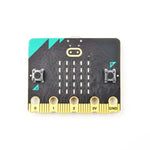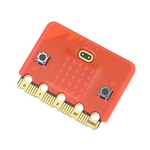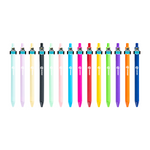Menú
Why is micro:bit the best choice for developing STEAM education in primary and secondary schools?
In 2012, the BBC designed the micro:bit programmable card as part of a computer literacy program for UK schools. The goal was to make learning programming and robotics more accessible to any child with purchasing power, so they created a microprocessor with multiple features and at the lowest possible price: the micro:bit, which gives schools a very affordable tool for teaching robotics in primary and secondary education (8+ years old). To program it, Microsoft developed MakeCode, a simple and free online graphical editor for learning block programming (Scratch type).
For just over £20, you can have a programmable card with all these features:

-
25 LEDs for displaying text, numbers and images
-
Light and temperature sensors
-
Accelerometer for detecting actions such as shaking, turning or releasing the card in free fall
-
Compass to know which direction you are facing
-
Radio for sending messages to each other in the classroom
-
Communicates with PCs, phones and tablets via Bluetooth
-
Microphone, speaker and touch sensor.
When people get over the initial fog of all things microbit, it soon becomes clear that everything is based on the same computer basics and knowledge, which can be learned and used more intuitively and understandably by children when using microbit. The microbit manages both entertainment and teaching very well, and teaching is completely different when children enjoy it and are well motivated to learn new things. And micro:bit keeps young children interested and allows them to enter the world of programming more quickly and fun.
A large reason for the success of micro:bit is that, as open source, dozens of independent companies from all over the world have made various supplements to expand it and add more possibilities. It is an evolving platform. I am not saying that it will grow anywhere, but it is like a growing chair, which is very suitable for children of any age. Among these companies, ELECFREAKS has become the preferred choice of most teachers and students with its rich and comprehensive product system and good product compatibility.
Starting with the micro:bit card as the "brain", after we have learned the basic functions, the children will start to learn more complex robots with electronic devices, sensors, etc. This can add expansion kits to learn building technology, robotics, construction technology, smart cars, home automation homes or greenhouses connected to the IoT, etc. You can find all these kits at ELECFREAKS. In this article, we focus on the robot part of the ELECFRAKS product system.
Robots for different ages and learning different technologies, as well as a wealth of expansion accessories

TP-Bot is a car robot designed for curious children. Out of the box, it can be a toy, and when it is not inserted into the microbit, it is a cute and nice car. After inserting the microbit, it becomes a learning robot with functions such as driving along a line, detecting obstacles, etc.! You can also create various projects with the TB-Bot robot - there are connectors for PlanetX modules on the back.
Compatible with LEGO® building blocks, TB-Bot is the most suitable product for the youngest children among all ELECFREAKS products, suitable for teaching complete programming basics in the early grades. Students can make full use of the TB-Bot Robot and connect other PlanetX modules to it. Like all microbit robots and projects, the TPBot robot can be wirelessly controlled using the gamepad module. This module is not only suitable for playing, but also for teaching wireless control.

Cutebot is a smart racing car that will surprise you with its speed and capabilities. If you catch up with him, he will honk at you, shine, or show you how he avoids obstacles or follows a course! As with all ELECFREAKS products, there are fun projects for both entertainment and teaching programming. You can expand the battery-specific pack for Cutebot, and after upgrading the battery port to a lithium battery, you can charge Cutebot like a mobile phone, which can save a lot of time.
You can also add a smart camera to Cutebot, which will take its capabilities to a completely different level. Just put the battery in Cutebot, insert the micro-drill and start programming. Therefore, it is suitable for fun teaching of programming for grade II. Elementary and secondary schools. For example, with the help of the rear connector for the Octopus module, you can transform it into a small weather station. The whole body of the robot is on one electronic board, so just plug the distance sensor into the correct connector to assemble the robot.

Cutebot Pro Car is a racing car with a higher age requirement. Compared with the basic version of cutebot car, it not only has all the functions of cutebot, but also goes a step further, upgrading the closed-loop motor, 4-way line patrol sensor and additional motor expansion interface, adding more structural holes and other functions. This allows the Pro version robot to receive instructions more accurately, drive routes more accurately, identify more complex intersections such as crossroads or T-junctions, integrate line simulation data, realize PID line patrol, and combine multiple sensors and building blocks to achieve more application scenarios. It can also expand structural devices such as robotic arms to create more practical cases.

Micro:bit XGO V2 robot dog is a robot with artificial intelligence for the microbit platform. XGO V2 has 15 degrees of freedom, so it can perform various stunts and action creations. In addition, he can grasp and carry objects and can bark loudly. Learn the basics of programming and the use of artificial intelligence AI in a fun way. XGO V2 will delight beginners and advanced users. His creations mainly appeal to younger children, who are well shown what can be created with a small card like a micro:bit.
Of course, younger children, such as those in first grade, will need guidance and help in programming this robot. In addition, programming is indeed a piece of cake thanks to the completed expansion, and the robot is controlled by commands like a live dog. In elementary and middle schools, you can already use the robot to learn artificial intelligence technology, perform more complex tasks and exercises. You can also connect other Octopus modules to the robot or use PlanetX to slow it down.

The Joystick:bit V2 is a game board developed based on the micro:bit, which contains a 4-way joystick and 4 undefined buttons, as well as an onboard buzzer and vibration motor to enhance the gaming experience. But the Joystick:bit V2 can be used as a remote control in more scenarios. It can control all the robots we mentioned above, which is done through signal transmission between two micro:bits. This helps the robot expand its scope of use and also allows teamwork among students in the classroom, such as using it to control Cutebot for football games, etc.

The micro:bit Retro Programming Arcade is a color screen joystick expansion board for micro:bit V2, including a TFT 160*128 color screen, 4 direction keys, two A/B keys and a reset key. Program games online and play games offline on the Microsoft Arcade programming platform. This is a simple and fun way to help children write their own games and understand the mysteries behind the games. It also supports the use of graphical programming software to customize game characters, diverse scenes and plot design, so that everyone can easily achieve interesting electronic creations and unlimited game creativity.
But in addition to being a game programming learning machine, it can also be used as a remote control handle to play the function of Joystick: bit to control all robots.
That's all about the robot system. Thank you for your watching. In the next time, I will introduce you to our sensor system.
Before that, welcome to the official website of ELECFREAKS to explore more content: https://shop.elecfreaks.com/
- Elegir una selección da como resultado una actualización de página completa.









